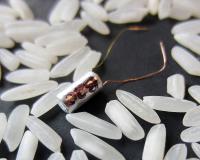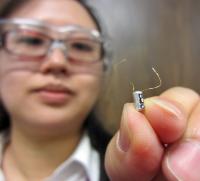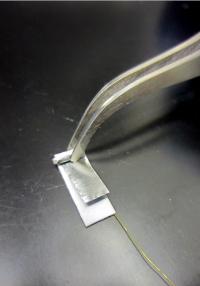
This image shows the microbattery, created by Jie Xiao and Daniel Deng and colleagues, amid grains of rice. Scientists have created a microbattery that packs twice the energy compared to current microbatteries used to monitor the movements of salmon through rivers in the Pacific Northwest and around the world.
The battery, a cylinder just slightly larger than a long grain of rice, is certainly not the world's smallest battery, as engineers have created batteries far tinier than the width of a human hair. But those smaller batteries don't hold enough energy to power acoustic fish tags. The new battery is small enough to be injected into an organism and holds much more energy than similar-sized batteries.
Details of the battery, created by scientists at the Department of Energy's Pacific Northwest National Laboratory, were published online recently in Scientific Reports, a member of the Nature collection of journals. Research about the battery's materials was also featured last year in the Journal of Materials Chemistry A.
For scientists tracking the movements of salmon, the lighter battery translates to a smaller transmitter which can be inserted into younger, smaller fish. That would allow scientists to track their welfare earlier in the life cycle, oftentimes in the small streams that are crucial to their beginnings. The new battery also can power signals over longer distances, allowing researchers to track fish further from shore or from dams, or deeper in the water. 
This image shows Jie Xiao holding the microbattery her team created.
"The invention of this battery essentially revolutionizes the biotelemetry world and opens up the study of earlier life stages of salmon in ways that have not been possible before," said M. Brad Eppard, a fisheries biologist with the Portland District of the U.S. Army Corps of Engineers.
"For years the chief limiting factor to creating a smaller transmitter has been the battery size. That hurdle has now been overcome," added Eppard, who manages the Portland District's fisheries research program.
The Corps and other agencies use the information from tags to chart the welfare of endangered fish and to help determine the optimal manner to operate dams. Three years ago the Corps turned to Z. Daniel Deng, a PNNL engineer, to create a smaller transmitter, one small enough to be injected, instead of surgically implanted, into fish. Injection is much less invasive and stressful for the fish, and it's a faster and less costly process.
"This was a major challenge which really consumed us these last three years," said Deng. "There's nothing like this available commercially, that can be injected. Either the batteries are too big, or they don't last long enough to be useful. That's why we had to design our own."
Deng turned to materials science expert Jie Xiao to create the new battery design.
To pack more energy into a small area, Xiao's team improved upon the "jellyroll" technique commonly used to make larger household cylindrical batteries. Xiao's team laid down layers of the battery materials one on top of the other in a process known as lamination, then rolled them up together, similar to how a jellyroll is created. The layers include a separating material sandwiched by a cathode made of carbon fluoride and an anode made of lithium. 
The battery is created by hand by rolling up layers of materials in a "jellyroll " technique.
The technique allowed her team to increase the area of the electrodes without increasing their thickness or the overall size of the battery. The increased area addresses one of the chief problems when making such a small battery – keeping the impedance, which is a lot like resistance, from getting too high. High impedance occurs when so many electrons are packed into a small place that they don't flow easily or quickly along the routes required in a battery, instead getting in each other's way. The smaller the battery, the bigger the problem.
Using the jellyroll technique allowed Xiao's team to create a larger area for the electrons to interact, reducing impedance so much that the capacity of the material is about double that of traditional microbatteries used in acoustic fish tags.
"It's a bit like flattening wads of Play-Doh, one layer at a time, and then rolling them up together, like a jelly roll," says Xiao. "This allows you to pack more of your active materials into a small space without increasing the resistance."
The new battery is a little more than half the weight of batteries currently used in acoustic fish tags – just 70 milligrams, compared to about 135 milligrams – and measures six millimeters long by three millimeters wide. The battery has an energy density of about 240 watt hours per kilogram, compared to around 100 for commercially available silver oxide button microbatteries.
The battery holds enough energy to send out an acoustic signal strong enough to be useful for fish-tracking studies even in noisy environments such as near large dams. The battery can power a 744-microsecond signal sent every three seconds for about three weeks, or about every five seconds for a month. It's the smallest battery the researchers know of with enough energy capacity to maintain that level of signaling.
The batteries also work better in cold water where salmon often live, sending clearer signals at low temperatures compared to current batteries. That's because their active ingredients are lithium and carbon fluoride, a chemistry that is promising for other applications but has not been common for microbatteries.
Last summer in Xiao's laboratory, scientists Samuel Cartmell and Terence Lozano made by hand more than 1,000 of the rice-sized batteries. It's a painstaking process, cutting and forming tiny snippets of sophisticated materials, putting them through a flattening device that resembles a pasta maker, binding them together, and rolling them by hand into tiny capsules. Their skilled hands rival those of surgeons, working not with tissue but with sensitive electronic materials.
A PNNL team led by Deng surgically implanted 700 of the tags into salmon in a field trial in the Snake River last summer. Preliminary results show that the tags performed extremely well. The results of that study and more details about the smaller, enhanced fish tags equipped with the new microbattery will come out in a forthcoming publication. Battelle, which operates PNNL, has applied for a patent on the technology. Source : tom.rickey@pnnl.gov
 Print Article
Print Article Mail to a Friend
Mail to a Friend
